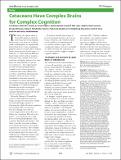Files in this item
Cetaceans have complex brains for complex cognition
Item metadata
| dc.contributor.author | Marino, Lori | |
| dc.contributor.author | Connor, Richard C. | |
| dc.contributor.author | Fordyce, R. Ewan | |
| dc.contributor.author | Herman, Louis M. | |
| dc.contributor.author | Hof, Patrick R. | |
| dc.contributor.author | Lefebvre, Louis | |
| dc.contributor.author | Lusseau, David | |
| dc.contributor.author | McCowan, Brenda | |
| dc.contributor.author | Nimchinsky, Esther A. | |
| dc.contributor.author | Pack, Adam A. | |
| dc.contributor.author | Rendell, Luke | |
| dc.contributor.author | Reidenberg, Joy S. | |
| dc.contributor.author | Reiss, Diana | |
| dc.contributor.author | Uhen, Mark D. | |
| dc.contributor.author | Van der Gucht, Estel | |
| dc.contributor.author | Whitehead, Hal | |
| dc.date.accessioned | 2013-12-04T11:01:01Z | |
| dc.date.available | 2013-12-04T11:01:01Z | |
| dc.date.issued | 2007-05 | |
| dc.identifier | 652854 | |
| dc.identifier | 7c6af4cc-c8fe-4281-a96a-3b5d1be23f73 | |
| dc.identifier | 000246716700002 | |
| dc.identifier | 34249030562 | |
| dc.identifier.citation | Marino , L , Connor , R C , Fordyce , R E , Herman , L M , Hof , P R , Lefebvre , L , Lusseau , D , McCowan , B , Nimchinsky , E A , Pack , A A , Rendell , L , Reidenberg , J S , Reiss , D , Uhen , M D , Van der Gucht , E & Whitehead , H 2007 , ' Cetaceans have complex brains for complex cognition ' , PLoS Biology , vol. 5 , no. 5 , e139 , pp. 966-972 . https://doi.org/10.1371/journal.pbio.0050139 | en |
| dc.identifier.issn | 1545-7885 | |
| dc.identifier.other | ORCID: /0000-0002-1121-9142/work/27612572 | |
| dc.identifier.uri | https://hdl.handle.net/10023/4252 | |
| dc.description.abstract | The brain of a sperm whale is about 60% larger in absolute mass than that of an elephant. Furthermore, the brains of toothed whales and dolphins are significantly larger than those of any nonhuman primates and are second only to human brains when measured with respect to body size. How and why did such large brains evolve in these modern cetaceans? One current view of the evolution of dolphin brains is that their large size was primarily a response to social forces—the requirements for effective functioning within a complex society characterized by communication and collaboration as well as competition among group members. In such a society, individuals can benefit from the recognition of others and knowledge of their relationships and from flexibility in adapting to or implementing new behaviors as social or ecological context shifts. Other views focus on the cognitive demands associated with the use of echolocation. Recently, Manger made the controversial claim that cetacean brains are large because they contain an unusually large number of thermogenic glial cells whose numbers increased greatly to counteract heat loss during a decrease in ocean temperatures in the Eocene-Oligocene transition. Therefore, he argues, cetacean brain size could have evolved independently of any cognitive demands and, further, that there is neither neuronal evidence nor behavioral evidence of complex cognition in cetaceans. These claims have garnered considerable attention in the popular press, because they challenge prevailing knowledge and understanding of cetacean brain evolution, cognition, and behavior. We believe that the time is ripe to present an integrated view of cetacean brains, behavior, and evolution based on the wealth of accumulated and recent data on these topics. Our conclusions support the more generally accepted view that the large brain of cetaceans evolved to support complex cognitive abilities. | |
| dc.format.extent | 7 | |
| dc.format.extent | 1415654 | |
| dc.language.iso | eng | |
| dc.relation.ispartof | PLoS Biology | en |
| dc.subject | BOTTLE-NOSED DOLPHINS | en |
| dc.subject | RESIDENT KILLER WHALES | en |
| dc.subject | ODONTOCETI TOOTHED WHALES | en |
| dc.subject | TURSIOPS-TRUNCATUS | en |
| dc.subject | CULTURAL TRANSMISSION | en |
| dc.subject | SELF-RECOGNITION | en |
| dc.subject | CEREBRAL-CORTEX | en |
| dc.subject | VOCAL MIMICRY | en |
| dc.subject | WHITE-MATTER | en |
| dc.subject | ORCINUS-ORCA | en |
| dc.title | Cetaceans have complex brains for complex cognition | en |
| dc.type | Journal article | en |
| dc.contributor.institution | University of St Andrews. School of Biology | en |
| dc.contributor.institution | University of St Andrews. Bioacoustics group | en |
| dc.contributor.institution | University of St Andrews. Centre for Social Learning & Cognitive Evolution | en |
| dc.identifier.doi | 10.1371/journal.pbio.0050139 | |
| dc.description.status | Peer reviewed | en |
This item appears in the following Collection(s)
Items in the St Andrews Research Repository are protected by copyright, with all rights reserved, unless otherwise indicated.

